Highlights
- For women ages 25 to 39, higher incomes are associated with higher marriage rates. Post This
- Among women, college education is a better predictor of marriage than income. Post This
- Unlike with women, the lowest-earning men are far less likely to be married (20%) than the highest-earning men (61%). Post This
- While college-educated young adults are more likely to get married in a given year, higher-earning men and women without degrees also have decent chances of getting married. Post This
It's no secret that men who earn more money are more likely to marry. After all, as a Pew report noted, "Americans place a higher value on a man’s role as financial provider." But does this relationship hold true for women? Or are high earnings irrelevant—or even detrimental—for women in the marriage market?
Recent American Community Survey (ACS) data shows that, among women ages 25 to 39, the lowest earners are about as likely to be married (56%) as the highest earners (57%).1 At first glance, this suggests that there is no connection between a woman's personal income2 and her odds of tying the knot. However, the same data reveals that women with higher personal incomes are much more likely to have gotten married in the past year than those with lower incomes. This article will explore this apparent contradiction—and examine how higher education helps explain the link between income and marriage.
Focus on Marriage Rates, Not Prevalence
Using survey data to determine the effects of women's income on their marital status is challenging. This is because many women may choose to work part-time, or not work at all, after getting married and having kids. As a result, a comparison of marriage prevalence by personal income may create the appearance that lower-earning women are more likely to get married—when, in fact, many such women might have been high earners prior to their wedding.
To control for this, I instead examined the percentage of women at different personal income levels who got married in the past year. This approach greatly reduces, if not eliminates, the effect of marriage itself on women's personal incomes.
Are Higher-Earning Women More Likely to Marry?
As it turns out, for women ages 25 to 39, higher incomes are associated with higher marriage rates. ACS data from 2019 to 2023 shows that, among women who had never previously been married, 10% of those in the highest income quintile reported getting married in the past year; meanwhile, only around 5% of the lowest-earning women did.2
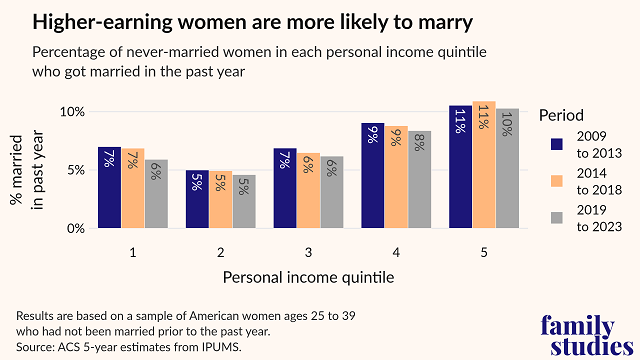
The relationship between income and relative marriage rates has remained relatively steady since 2009. In each of the periods shown, women in the highest personal income quintile were the most likely to marry, followed by those in the second-highest quintiles. This should help dispel concerns that men might be 'turned off' by higher-earning women.
It's interesting to contrast the numbers in the above chart with those in the following visualization, which shows the percentage of all women ages 25-39 who are married. As noted earlier, women in the lowest and highest personal income quintiles have similar odds of being married; in addition, they're also more likely to be married than those in the middle three quintiles. However, as the previous chart demonstrates, women in the lowest income quintile were only around half as likely to have married in the past year as those in the highest income quintile.
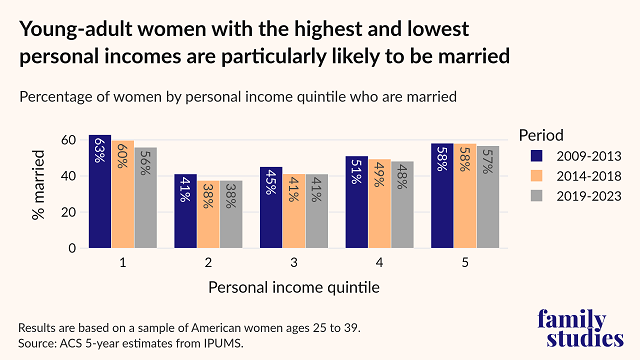
A plausible explanation for this discrepancy is that many women choose to work part time or not at all after getting married. In other words, lower personal incomes don't increase women's chances of marrying; rather, getting married leads to lower personal incomes for women who choose to stay at home.
College Education May Largely Explain the Income-Marriage Link
What might explain the connection between higher incomes and higher marriage rates among women? One possibility is that college-educated women are more likely to both get married and have higher personal incomes. The following chart supports this argument: It shows that, within each income group, college-educated women are indeed more likely than non-college-educated women to get married.
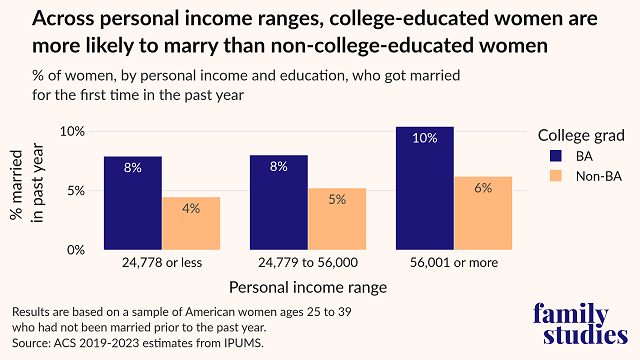
Among women, college education is a better predictor of marriage than income. After all, a higher percentage of low-earning women with college degrees got married in the past year (8%) than did high-earning women without degrees (6%). However, this finding should be interpreted with caution, as these figures may not accurately reflect women's incomes in the year prior to their marriage.
Even when controlling for education, though, there still appears to be a link between income and marriage. Among women with college degrees, those in the highest income group (10%) were more likely to get married than those in the lowest income group (8%). These numbers may actually understate the relationship between income and education, as at least some of the college-educated women in the lowest-income group may previously have been high earners who chose to become homemakers in the year after their wedding. Similarly, higher-earning women without degrees were more likely to get married (6%) than lower-earning women without degrees (4%).
For Men, Higher Incomes and Education Are Also Linked to Marriage
What do these same trends look like for men? When I applied a similar approach to evaluate marriage odds for young men, a very clear positive relationship between income and getting married emerged. From 2019 to 2023, 11% of men in the highest income quintile got married in the past year, but only 2% of men in the lowest quintile did. Previous periods show a similar connection between personal incomes and marriage.
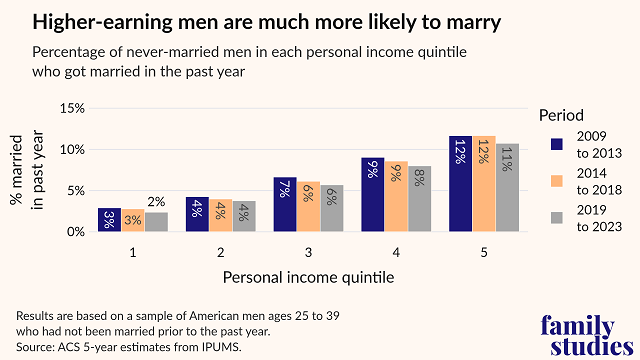
Unlike with women, the lowest-earning men are far less likely to be married (20%) than the highest-earning men (61%). At least some of these low-earning men are undoubtedly stay-at-home dads who previously earned a higher salary; however, their numbers are too small to make much of an impact.

However, there's also a clear link between college education and marriage for men. Within each income tertile in the following chart, college-educated men are more likely than men without a college degree to get married. Conversely, higher-earning men within each education group are more likely to marry than are lower-earning men in that same group.
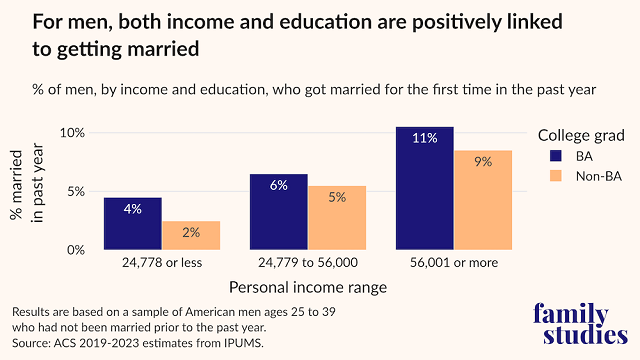
As discussed earlier, higher-earning women who didn't graduate from college were less likely to report a recent marriage than lower-earning women with degrees. However, this pattern does not hold true for men: 9% of high-earning men without college degrees got married in the past year compared to 4% of low-earning men with degrees. This is good news for men who are thinking of foregoing college to pursue work as a plumber or electrician: the high earnings they can enjoy in those professions should offset their lack of a college degree when they enter the marriage market.
Implications
We can draw several tentative conclusions from these findings.
First, while college-educated young adults are more likely to get married in a given year, higher-earning men and women without degrees also have decent chances of getting married. This news provides hope both for college-educated young adults with lower incomes and those who have found lucrative work without a degree.
Second, these findings, like Lyman Stone's, also counter the popular narrative that men interpret successful women as a threat. If the majority of men were truly put off by women with high incomes or higher education, we could expect to see higher marriage rates among lower-income women and those without degrees; however, the opposite is true: successful women still get married.
Third, the connection between income and marriage suggests that many young Americans continue to view marriage as a 'capstone' rather than a 'cornerstone.' Couples may not feel comfortable with the idea of marriage until they have attained a relatively high annual salary. But, as Robert Lerman notes, lower-income couples can also benefit from matrimony:
marriage significantly and substantially reduces the likelihood of poverty, holding constant for family background, race and ethnicity, age, education, and marital vs. non-marital childbearing.
Because these findings are correlational in nature, however, they do not prove that that income and higher education cause one's odds of marrying to increase. Instead, several additional factors may be contributing to higher incomes and higher marriage rates, such as conscientiousness, social capital, and positive lifestyle choices. Additional research, including longitudinal studies, can help confirm whether income and education have a direct impact on marriage rates.
Ultimately, policymakers, religious leaders, and others should consider ways to help boost marriage rates among low-income Americans and those without college degrees; otherwise, this institution will continue to be perceived as a 'luxury good'. Furthermore, if the majority of those who enjoy the financial benefits of marriage are already better off, the gap in wealth and income between higher- and lower-income Americans may continue to expand.
Ken Burchfiel is a Research Fellow at the Institute for Family Studies.
Endnotes
1. Citation for the IPUMS dataset from which this data was retrieved: Steven Ruggles, Sarah Flood, Matthew Sobek, Daniel Backman, Grace Cooper, Julia A. Rivera Drew, Stephanie Richards, Renae Rogers, Jonathan Schroeder, and Kari C.W. Williams. IPUMS USA: Version 16.0 [dataset]. Minneapolis, MN: IPUMS, 2025. https://doi.org/10.18128/D010.V16.0
To help control for the effects of previous marriages and marriage itself on income, I limited my sample for marriage-rate analyses to individuals who had either gotten married for the first time within the past year or had never married. (This filter was not applied for marriage prevalence analyses.) In addition, in order to focus my analyses on heterosexual marriages, I also filtered my income comparison dataset to exclude same-sex marriages. (However, because spousal sex data was not available for spouses outside respondents' households, a small percentage of same-sex couples may still have gotten incorporated in my marriage rate calculations.)
The ACS dataset reports personal incomes for the past twelve months rather than at the time individuals got married. Thus, the incomes within this dataset may differ significantly from those that respondents had on the day they were married.
2. All income values in this article reflect personal incomes rather than family or household incomes. In other words, if a woman earns $10,000 but her husband or partner earns $80,000, her income for the purposes of this article will be $10,000, not $90,000.
3. These income levels were calculated by dividing personal incomes for all adults aged 25-39, regardless of educational, marital, or parental status, into weighted quintiles and tertiles. Separate quintiles and tertiles were calculated for the three 5-year periods presented in this article.













